Introduction
In general, Hibiscus included over 300 species of annual or perennial herbs, shrubs or trees [1, 2]. Hibiscus sabdariffa Linnaeus was recognized as Roselle and was an ideal crop for developing countries because it could be relatively easy to cultivate [1, 2]. Also Hibiscus sabdariffa Linnaeus (Roselle) could be used as food and fiber, and also cultivated as part of multi-cropping systems [1]. Until now, Hibiscus sabdariffa Linnaeus (Roselle) was used as a traditional foods or medicine depending on the region [1, 3]. For example, in Africa, India and Mexico, the infusions of the leaves or calyces of Hibiscus sabdariffa Linnaeus (Roselle) were used for having a good effect on cholerectic, diuretic, febrifuge, hypotension, and so on, and were traditionally used for stimulating the intestinal peristalsis and for decreasing the blood’s viscosity [1–3]. In North Africa, the preparations of calyces of Hibiscus sabdariffa Linnaeus (Roselle) were used to treat coughs, genital problems, sore throats, and so on [1, 3, 4]. And in folk medicine of China, it was used to treat high blood pressure and liver disorders [1, 5]. Furthermore, the main components related to the pharmacological effects of Hibiscus sabdariffa Linnaeus (Roselle) were anthocyanins, flavonoids, hibiscus acid, hydrooxycitric acid, organic acids, polysaccharides (carbohydrates, mucilage and pectin), volatile compounds, and so on [1, 3, 6]. The various biofunctional and pharmacological characteristics of Hibiscus sabdariffa Linnaeus (Roselle) was shown in Fig. 1 [1, 3]. Therefore, Hibiscus sabdariffa Linnaeus (Roselle) powder could be added directly to several dairy products because it could improves the sensory profiles and the human health through several bioactive components.
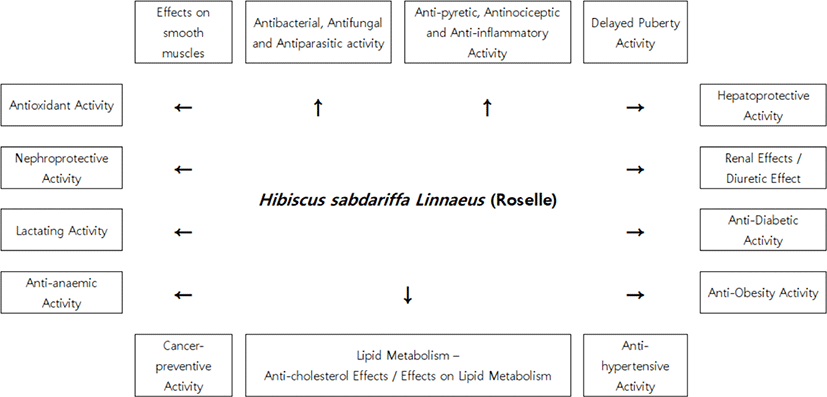
Subsequently, the ultimate objective of this study was to prepare market milk, yoghurt and Kefir added with the powder of Hibiscus sabdariffa Linnaeus (Roselle) for upgrading the sensory profiles with having biofunctional properties.
Materials and Methods
The organic Roselle Hibiscus extract powder which was made up of 100% Hibiscus sabdariffa Linnaeus (Roselle) as the food-additive grade was grown in Poland (Lilly Super Food, Korea).
According to the method [7], the powder of Hibiscus sabdariffa Linnaeus (Roselle) was added to market milk (Seoul Dairy Co-op, Korea) in 1% increments, from 0% (control) to 4%, respectively,
According to the modified method [7], the powder of Hibiscus sabdariffa Linnaeus (Roselle) was added to yoghurt in 1% increments, from 0% (control) to 4%, respectively.
According to the modified method [7], the powder of Hibiscus sabdariffa Linnaeus (Roselle) was added to Kefir in 1% increments, from 0% (control) to 4%, respectively.
According to method [8], the titratable acid (TA) and pH of market milk, yogurt and Kefir added with the powder of Hibiscus sabdariffa Linnaeus (Roselle) was analyzed by titration with 0.1 N NaOH (Sigma-Aldrich Co., USA), and by the pH meter (Orion Star A211, USA), respectively.
Market milk, yogurt and Kefir added with powder of Hibiscus sabdariffa Linnaeus (Roselle) were manufactured and kept in fridge until they were analyzed. All 13 appraisers participated in this study, and then evaluated the sensory profiles for each sample. In this study, the samples were randomly tested in disposable paper cups (50 mL) at 10°C. The sensory profiles consisted of five different categories (Table 1).
| Category of sensory profiles | Five-point hedonic value |
|---|---|
| Overall acceptability | 1 : Extremely poor |
| Texture | 2 : Poor |
| Flavor | 3 : Fair |
| Color | 4 : Good |
| Taste | 5 : Excellent |
In this study, all results were taken from two separate experiments with duplicate assays. Using the statistical software of GraphPad Prism 5 (GraphPad Softward Inc., USA), results was analyzed. Also, all results were demonstrated as means±SD. There was a statistically significant difference between the groups (p<0.05).
Results and Discussion
TA generally affected pH levels [8]. In this study, the pH and TA of market milk was about 6.65 and 0.15%, respectively. And the pH of yogurt and Kefir dropped to 4.35 and 4.50, respectively, whereas the TA of yogurt and Kefir went up to 1.0% and 0.94, respectively (Data not shown).
The level of TA and pH of market milk, yogurt and Kefir added with the powder of Hibiscus sabdariffa Linnaeus (Roselle) in 1% increments (from 1.0% to 4.0%) demonstrated similar to that of market milk, yogurt and Kefir without having the powder of Hibiscus sabdariffa Linnaeus (Roselle) (Data not shown). Therefore, the TA and pH did not represent any statistical significant difference between treated group and control group conducted in this study. This study also showed a similar tendency to various previous studies [8–10].
The sensory profiles of market milk were evaluated by thirteen appraisers. Fig. 2 showed the summary of sensory profiles.
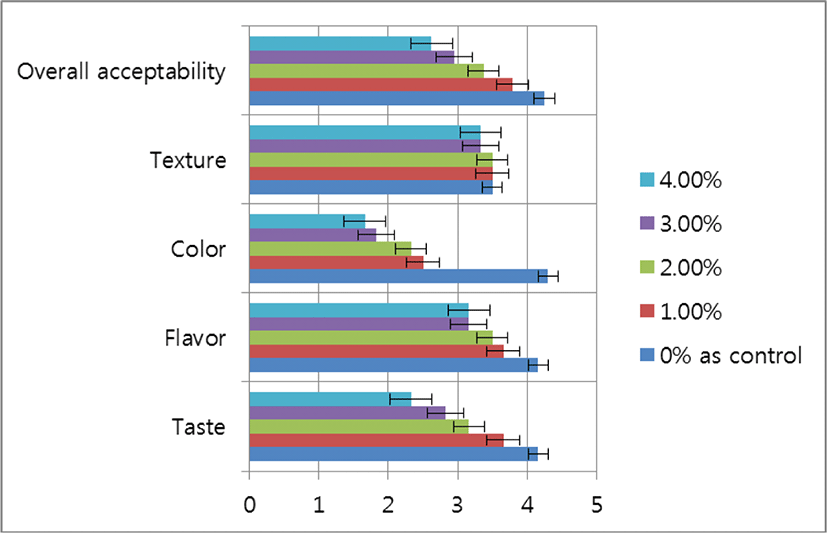
The powder of Hibiscus sabdariffa Linnaeus (Roselle) was added to market milk in 1% increments, from 0% (control) to 4%, respectively. The taste value of market milk added with the powder of Hibiscus sabdariffa Linnaeus (Roselle) in 1% increments (from 1.0% to 4.0%) was from 3.66 to 2.33, which were lower than 4.16 of control group (addition of 0%). The flavor value of market milk added with the powder of Hibiscus sabdariffa Linnaeus (Roselle) in 1% increments (from 1.0% to 4.0%) was from 3.66 to 3.16, which was lower than 4.16 of control group (addition of 0%). The color value of market milk added with the powder of Hibiscus sabdariffa Linnaeus (Roselle) in 1% increments (from 1.0% to 4.0%) was from 2.5 to 1.66, which was lower than 4.3 of control group (addition of 0%). The texture value of market milk added with the powder of Hibiscus sabdariffa Linnaeus (Roselle) in 1% increments (from 1.0% to 4.0%) was from 3.5 to 3.33, which was similar or lower than 3.5 of control group (addition of 0%). And the overall acceptability value of market milk added with the powder of Hibiscus sabdariffa Linnaeus (Roselle) in 1% increments (from 1.0% to 4.0%) was from 3.79 to 2.62, which was lower than 4.25 of control group (addition of 0%). According to statistical analysis on the sensory profiles of market milk, there was a statistically significant difference in taste, flavor, color, and overall acceptability between treated group and control group (p<0.05). Among the treated group, the market milk added with 1% of Hibiscus sabdariffa Linnaeus (Roselle) powder showed the best results compared with control group.
In a word, as the addition of Hibiscus sabdariffa Linnaeus (Roselle) powder increased, the category of taste, flavor, color, and overall acceptability tended to decrease except texture.
The sensory profiles of yogurt were evaluated by thirteen appraisers. Fig. 3 showed the summary of sensory profiles.
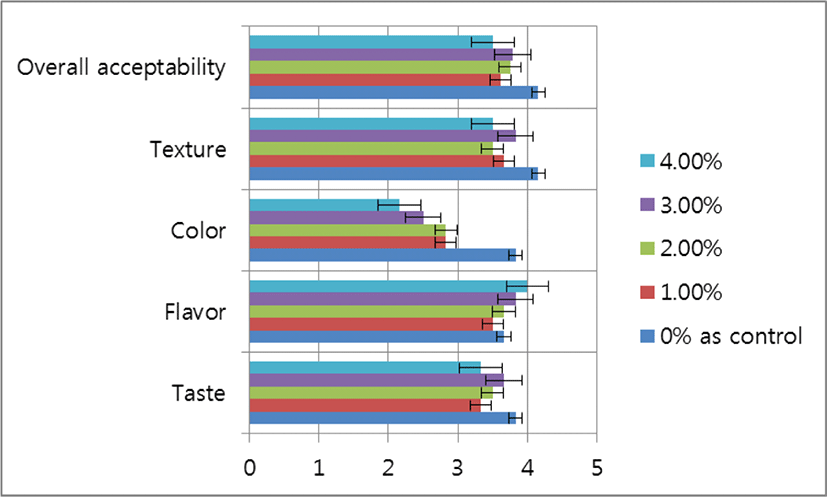
The powder of Hibiscus sabdariffa Linnaeus (Roselle) was added to yogurt in 1% increments, from 0% (control) to 4%, respectively. The taste value of yogurt added with the powder of Hibiscus sabdariffa Linnaeus (Roselle) in 1% increments (from 1.0% to 4.0%) was from 3.66 to 3.33, which were lower than 3.83 of control group (addition of 0%). The flavor value of yogurt added with the powder of Hibiscus sabdariffa Linnaeus (Roselle) in 1% increments (from 1.0% to 4.0%) was from 4.0 to 3.5, which were higher or lower (or similar) than 3.66 of control group (addition of 0%). The color value of yogurt added with the powder of Hibiscus sabdariffa Linnaeus (Roselle) in 1% increments (from 1.0% to 4.0%) was from 2.83 to 2.16, which were lower than 3.83 of control group (addition of 0%). The texture value of yogurt added with the powder of Hibiscus sabdariffa Linnaeus (Roselle) in 1% increments (from 1.0% to 4.0%) was from 3.83 to 3.5, which were lower than 4.16 of control group (addition of 0%). And the overall acceptability value of yogurt added with the powder of Hibiscus sabdariffa Linnaeus (Roselle) in 1% increments (from 1.0% to 4.0%) was from 3.79 to 3.5, which were lower than 4.16 of control group (addition of 0%).
According to statistical analysis on the sensory profiles of yogurt, there was a statistically significant difference in taste, color, texture and overall acceptability between treated group and control group (p<0.05). Among the treated group, the yogurt added with 3.0% (and 2.0%) of Hibiscus sabdariffa Linnaeus (Roselle) powder showed the best results compared with control group.
In a word, as the addition of Hibiscus sabdariffa Linnaeus (Roselle) powder increased, the category of taste, color, texture and overall acceptability tended to decrease except flavor.
The sensory profiles of Kefir were evaluated by thirteen appraisers. Fig. 4 showed the summary of sensory profiles.
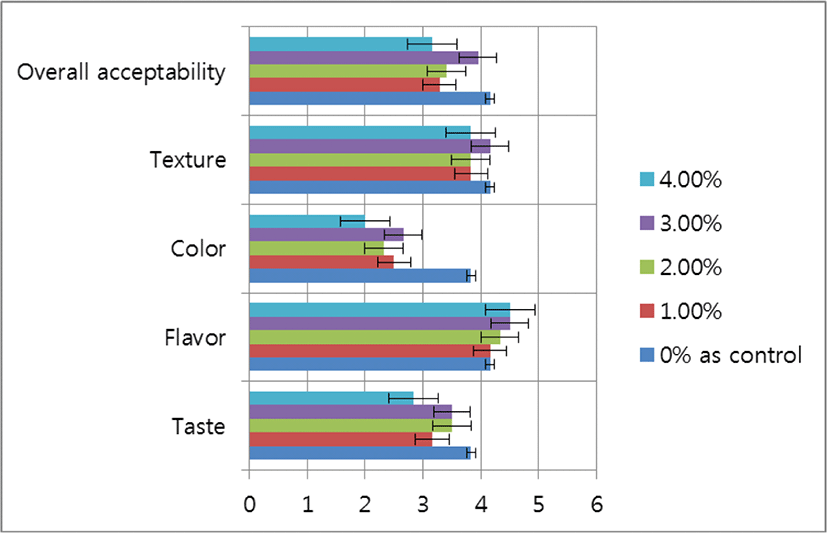
The powder of Hibiscus sabdariffa Linnaeus (Roselle) was added to Kefir in 1% increments, from 0% (control) to 4%, respectively. The taste value of Kefir added with the powder of Hibiscus sabdariffa Linnaeus (Roselle) in 1% increments (from 1.0% to 4.0%) was from 3.5 to 2.83, which were lower than 3.84 of control group (addition of 0%). The flavor value of Kefir added with the powder of Hibiscus sabdariffa Linnaeus (Roselle) in 1% increments (from 1.0% to 4.0%) was from 4.5 to 4.16, which were similar or lower (or similar) than 4.5 of control group (addition of 0%). The color value of Kefir added with the powder of Hibiscus sabdariffa Linnaeus (Roselle) in 1% increments (from 1.0% to 4.0%) was from 2.66 to 2.0, which were lower than 3.84 of control group (addition of 0%). The texture value of Kefir added with the powder of Hibiscus sabdariffa Linnaeus (Roselle) in 1% increments (from 1.0% to 4.0%) was from 4.16 to 3.83, which were lower than 4.17 of control group (addition of 0%). And the overall acceptability value of Kefir added with the powder of Hibiscus sabdariffa Linnaeus (Roselle) in 1% increments (from 1.0% to 4.0%) was from 3.95 to 3.16, which were lower than 4.17 of control group (addition of 0%).
According to statistical analysis on the sensory profiles of Kefir, there was a statistically significant difference in taste, color and overall acceptability between treated group and control group (p<0.05). Among the treated group, the Kefir added with 3.0% of Hibiscus sabdariffa Linnaeus (Roselle) powder showed the best results compared with control group.
In a word, as the addition of Hibiscus sabdariffa Linnaeus (Roselle) powder increased, the category of taste, color, texture and overall acceptability tended to decrease except flavor.
Next, Fig. 5 showed the changes of color in market milk-, yoghurt-, and Kefir-added with the powder of Hibiscus sabdariffa Linnaeus (Roselle) in 1% increments (from 1.0% to 4.0%). In this study, yogurt and Kefir added with the powder of Hibiscus sabdariffa Linnaeus (Roselle) in 1% increments (from 1.0% to 4.0%) had no red color change, but market milk added with the powder of Hibiscus sabdariffa Linnaeus (Roselle) in 1% increments (from 1.0% to 4.0%) changed from red to gray (Fig. 5). It may be thought that the color of market milk added with the powder of Hibiscus sabdariffa Linnaeus (Roselle) changed under the influence of pH. And it could be explained in more detail for the following reason. The colorful anthocyanins were known as the flavonoids group of phytochemicals, and also anthocyanins’s molecules were susceptible to degradation. For example, the stability of colorful anthocyanins’s molecules depended on light, metals, pH, phenolic acids, temperature, the presence of enzyme or other flavonoids, and so on [3]. However, more detailed research will have to be done.
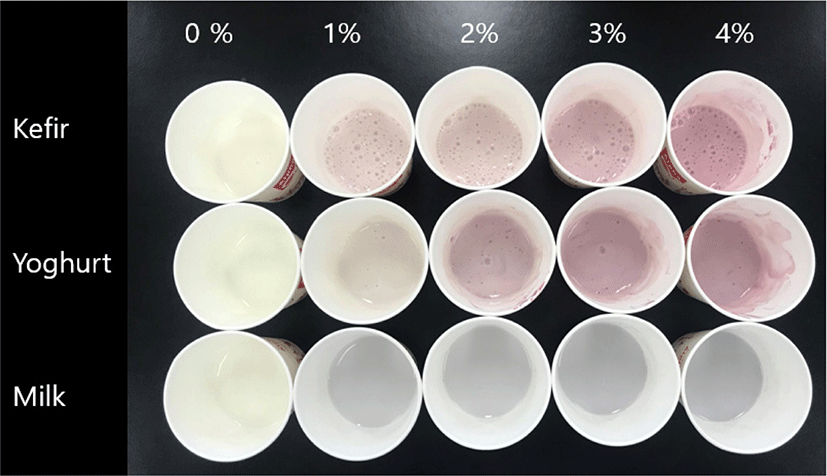
Hibiscus sabdariffa Linnaeus (Roselle) was generally grown for its calyces and fibers, and also was divided into 3 types of genotypes such as dark red, green, and red [11, 12]. Among them, the genotype of red was the most common type used [12]. Especially, anthocyanins were a group of phenolic compounds and could be found in a variety range of fruits and flowers to demonstrate the reddish-purple color [11]. Furthermore, anthocyanins could be used for natural alternatives to replace the artificial synthetic color additives in the food industry [11]. Especially, the calyx of Hibiscus sabdariffa Linnaeus (Roselle) was known to contain the compounds responsible for the red color of this plant, which were delphinidin-3-glucoside, cyaniding-3-glucoside, delphinidin3-sambubioside, cyaniding-3-sambubioside, and so on [13].
In conclusion, even though Hibiscus sabdariffa Linnaeus (Roselle) powder may be effective in improving human health according to previous studies [1–4, 11, 13], more future research on the availability of Hibiscus sabdariffa Linnaeus (Roselle) extracts as a natural color ingredients as well as the development of various biofunctioanl dairy products must be carried out.
